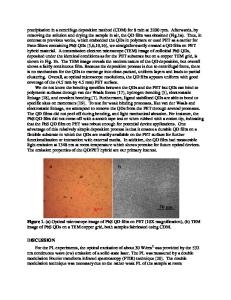Formation of novel photoluminescent hybrid materials by sequential vapor infiltration into polyethylene terephthalate fi
- PDF / 723,350 Bytes
- 10 Pages / 584.957 x 782.986 pts Page_size
- 74 Downloads / 269 Views
chael Lo and Eoghan Dillon Anasys Instruments, Inc., Santa Barbara, California 93101, USA
Adam T. Roberts Army Aviation and Missile Research, Development, and Engineering Center, Redstone Arsenal, Huntsville, Alabama 35898, USA
Henry O. Everitt Army Aviation and Missile Research, Development, and Engineering Center, Redstone Arsenal, Huntsville, Alabama 35898, USA; and Department of Physics, Duke University, Durham, North Carolina 27708, USA
Jesse S. Jura) Department of Textile Engineering, Chemistry and Science, North Carolina State University, Raleigh, North Carolina 27695, USA (Received 16 June 2014; accepted 14 October 2014)
Fibrous polyethylene terephthalate (PET) was modified by organometallic vapor exposure to form hybrid materials with unique photoluminescent characteristics. Using a sequential vapor infiltration (SVI) process, the elongated exposures of trimethylaluminum (TMA) to PET were examined. As the infiltration temperature increased, the evidence of changes in the reaction between the organometallic vapor and the polymer was observed as well as significant changes in the infiltration depth into the polymer fiber, owing to the variation in the reaction mechanisms of the hybrid material formation. At TMA exposures of 60 °C, the mass of the polymer fiber increased by ;55 wt%, whereas exposures at 150 °C were limited to ;25 wt% infiltration. Photoluminescence analysis of PET after TMA infiltration shows an intensity increase of up to ;13x and an increase in red shift with increasing infiltration temperature, attributed to the variations in the reaction mechanism to form the hybrid modification observed through the spectroscopy analysis. I. INTRODUCTION
Polymeric substrates are of interest for flexible electronic applications because of their flexibility, relative ease of production, and lower cost. However, many conventional polymers are insulators and their electronic properties do not meet the requirements for device applications. Hybridization of such polymers can alter their electronic properties along with many properties, which can enable those low cost conventional polymers to be used for flexible electronic applications. Hybrid materials consisting of mixed organic and inorganic constituents show the ability to create novel materials for applications including biosensing,1 electronics,2 optics,3,4 and catalysis.5,6 These materials were fabricated using techniques including sol–gel,7 molecular layer deposition,8–10 and a)
Address all correspondence to this author. e-mail: [email protected] DOI: 10.1557/jmr.2014.333 J. Mater. Res., Vol. 29, No. 23, Dec 14, 2014
http://journals.cambridge.org
Downloaded: 11 Mar 2015
layer-by-layer deposition11,12 by incorporation of organic and inorganic building blocks via chemical synthesis. An alternative approach to form hybrid materials is to modify either organic or inorganic materials with reactive precursors to incorporate the other kind of material. The process, referred to herein as sequential vapor infiltration (SVI),13–15 is like similar vapor phase infiltration met
Data Loading...










